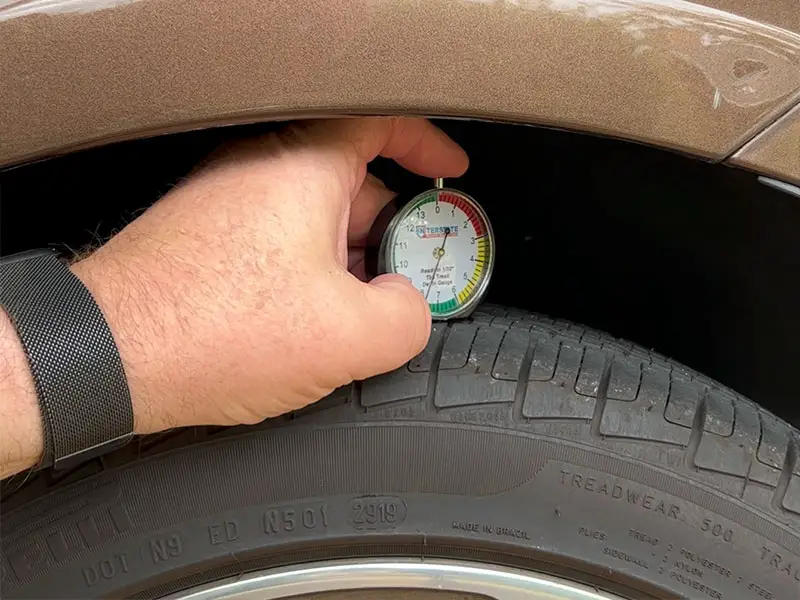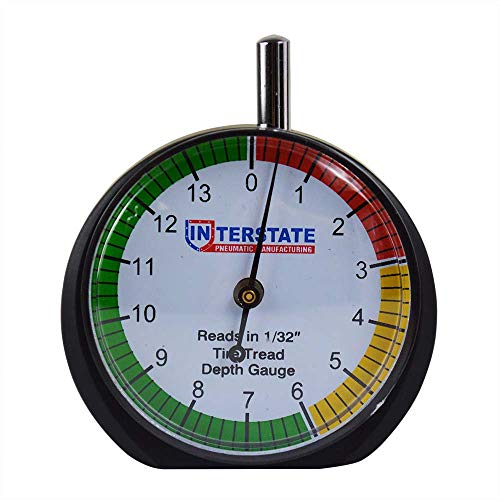Tread wear for passenger car tires is one of the most important factors in helping to prevent hydroplaning and maintaining traction in wet weather conditions.
It’s important to check tire tread depth not only to ensure your tires are above the minimum legal tread depth in your area but also to ensure there isn’t uneven tread wear.
Minimum Tire Tread Depth
Legally, the minimum tread depth is going to vary from state to state:
- In 42 states, 2/32 is the legal minimum tread depth
- In 2 states, 1/32 is the legal minimum tread depth (California & Idaho)
- In 6 states, there is no legal minimum tread depth (Arkansas, Montana, North Dakota, South Carolina, West Virginia)
Laws change over time so be sure to check your local laws for verification.
When your treads get down to 2/32, your stopping distance increases by 100% when panic braking on wet roads. That’s twice the distance it takes brand-new tires to come to a complete stop, given the same starting conditions.
A tire tread depth gauge can give you a precise measurement, but tread wear indicator bars or the penny test can help you ensure you’re above the minimum tread depth requirements.
Let’s take a closer look
Remaining Tire Life Calculator
Tire Tread Life Expectancy Chart
What Do Tire Treads Do?
Your tire treads are among the most important parts of your car. As you’re driving, the tread is the only part of your car that comes in contact with the road.
As a result, your tire treads do a lot. They determine:
- How long it takes you to stop
- How quickly you can accelerate
- Your gas mileage
- Your car’s performance
- The safety factor of your car
- Your grip through turns, over hills, and on wet roads
Tread is designed to grip the road really well. There are different types of tire tread that might optimize driving on snowy roads, maximize your acceleration, or improve your gas mileage.
Your treads create friction between your car and the road. This friction allows you to drive safely, but it also wears out your tires and removes a layer of rubber every time your tire spins.
Over time, your treads will get lower which makes your car less safe to drive, hurts your performance, and ruins your fuel efficiency.
What Happens When Tire Tread Is Low?
We mentioned some of the downsides of low tire tread, but safety is the main issue. Brand-new tires will help you come to a complete stop relatively quickly, even in wet conditions. When the tread is low, there’s less friction available, so the stopping distance increases.
In one study, the testers looked into how critical tread depth was when it came to stopping distance. They found that, in wet conditions, your stopping distance could increase from about 160 feet up to 300 feet. That’s almost twice the distance.
What does this mean? It means that you’ll need much more distance between you and the thing you’re braking to avoid. If it’s a pedestrian walking on the road, you’re more likely to hit them if your tire tread is too low.
This is the main reason why experts suggest you replace your tires when the tread is too low. Once it gets to a certain point, you can’t predict how soon you’ll stop in an emergency situation. It can lead to car accidents.
Another big problem comes with driving in wet conditions with tires that don’t have deep enough treads. It’s something called “hydroplaning”.
Hydroplaning happens when a layer of water gets between your tire and the road. Water’s friction coefficient is very low, which means that it doesn’t provide good grip. As a reminder, the grip between the rubber of your tire and the asphalt of the road is the main reason why you can stop, accelerate, and perform well while you drive.
With shallower treads, it’s much easier to hydroplane. Once you start hydroplaning, you’ll lose all control of your car — you won’t be able to steer, slow down, or avoid any upcoming dangers.
Safe Tire Tread Depth
This leads us to the next point: what tire tread depth is considered “safe”? If you ask a tire expert, they’ll tell you that a safe tire tread depth is when you should change your tires.
By definition, this is the depth where things go from “safe” to “unsafe”. If you ignore the safe depth and continue driving, then your car will become increasingly unsafe until the tires are completely bald and you’re risking your life.
A lot of industry leaders suggest that the safe tire tread depth is around 4/32”. Any less than that, and things start to get unsafe. If you have more than 4/32”, then your tires are still healthy and safe.
What Is the Minimum Acceptable Tire Tread Depth in California?
Surprisingly, California is very lenient when it comes to tire depth. According to California Vehicle Code section 27465(b)(1), as long as your tires have at least 1/32” of thread depth in any two adjacent grooves, you can legally drive your car.
If you ask any other tire expert, they’ll point out that 1/32” of tread depth is incredibly unsafe. Your stopping distance on wet roads will likely be doubled or more at that point, and your car will react dangerously to braking, accelerating, or steering too aggressively.
However, as long as you have this much tread depth, you can legally drive on Californian streets.
What Is the Minimum Tread Depth for Front Tires?
A lot of cars on the road today are front-wheel drive (FWD). This means that the front two wheels are under power, and the rear two wheels are just moving thanks to the front ones.
In terms of tires, this means that the front two wheels do most of the heavy lifting. A lot of times, this results in the front wheels wearing sooner than the rear ones.
Even though they might wear unevenly, it’s imperative that you replace all four tires at the same time. If you just replace one or two of your tires, then there will be an imbalance of friction across your car. The new tires will create more stopping force than the old ones. If you look at the physics of this scenario, it will likely result in spinning out and losing control or pulling in one direction.
With that in mind, now we can discuss minimum thread depths. Since your front tires are controlling your car in a FWD vehicle, it’s a good idea to change them sooner rather than later. Waiting until 1/32 is definitely not acceptable.
In reality, you would want to change the front tires when the tread depth is around 4/32” to 2/32”, but it’s better not to wait until they get all the way to 2/32”.
Should I Replace My Tires At 5/32″?
At 5/32”, your stopping distance has only increased by about 35%. While this certainly makes a difference, it’s a bit too early to replace the tire.
There’s no mechanical downside to changing your tires really early. The only problem is that tires aren’t cheap, and prematurely changing them means wasting money and effort.
If you want to change them at 5/32”, there’s nothing stopping you, but we would suggest that you wait a little longer.
Should I Replace My Tires At 4/32″?
What about at 4/32”? Now would be a good time to think about changing your tires, but it isn’t required yet. Your stopping distance is 50% longer now, and you’ll start swinging into unsafe driving soon. We would say you should maybe replace your tires at 4/32” of tread depth.
Should I Replace My Tires At 3/32″?
At 3/32” of tread depth, the answer becomes more definitive. At this point, it’s a good idea to change your tires. The stopping distance is about 70% longer at this point, and it will just keep getting worse.
Should I Replace My Tires At 2/32”?
If you haven’t changed your tires yet and they’re down to 2/32” of tire depth, you absolutely want to change them now. If you wait any longer, your car will be incredibly unsafe. At this point, your stopping distance increased by about 100%.
How To Measure Tread Depth
The best way to measure your tread depth is to use a tire tread depth gauge. This is a specialized tool that will the thickness of your tread. You can also use the penny test or perform a visual inspection of the wear bars to get an idea of how close to needing to be replaced your tires are currently, but a penny or wear bars won’t be able to give you an exact measurement.
To use the penny test to see if your tread is too shallow, hold a penny so Lincoln is facing you and upside down. Insert the penny into your tire’s tread groove. If you can see Lincoln’s full head, then you have less than 2/32” of tread and you need to change your tires.
Resources
Below are some links you may find helpful when learning about tires
- Commentary: legal minimum tread depth for passenger cars in the U.S.A.–a survey – PubMed.gov
- Tread depth – Continental Tires
Final Thoughts
A tire tread depth gauge is a smart tool to keep in your glove box to occasionally check tire tread depth. If the remaining tread depth is greater than 2/32″ you’re at or above the minimum legal limit, but that minimum depth is not much different than driving on bald tires.
Braking performance and distance on wet pavement depend on the depth of your tire’s tread grooves that water uses to escape from underneath your tire’s contact patch.
We strongly recommend purchasing new tires when tread wear reaches 4/32″. This cut your braking distance in half if you need to come to an emergency stop in wet conditions.
Good luck and happy motoring.







